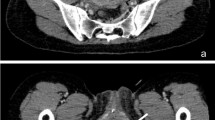Abstract
Introduction and hypothesis
Various methods are used in pelvic organ prolapse (POP) surgery. Organ-preserving methods are gaining importance and popularity. Although the success rates of abdominal sacrocervicopexy, which is one of these methods, are known, data on pregnancy outcomes are insufficient. The aim of this study was to investigate pregnancy outcomes after abdominal sacrocervicopexy.
Methods
This study included 72 patients with a diagnosis of POP who underwent abdominal sacrocervicopexy with monofilament polypropylene mesh in Diyarbakir Gazi Yaşargil Training and Research Hospital between 2008 and 2016. Anterior and posterior colporrhaphy operations were performed. Postoperatively, these patients were followed up for a mean of 29.68 ± 6.55 (20–49) months. Pregnancy and recurrence outcomes of those who became pregnant were recorded and analyzed.
Results
On average, pregnancies occurred 23.2 (18–30) months after the operation. During follow-up, eight patients became pregnant and gave birth without any issues or complications. One had a normal vaginal delivery, and seven gave birth by cesarean section. One of the pregnant women had a twin pregnancy. When 24 patients who underwent bilateral tubal ligation and postmenopausal (n = 2) were excluded, the pregnancy rate was found to be 17.3%. The weeks of the deliveries were 35 weeks (twin pregnancy), 38 weeks (n = 2), 39 weeks (n = 3), and 40 weeks (n = 1), for an average of 38.5 weeks.
Conclusions
Eight patients who had undergone abdominal sacrocervicopexy had healthy pregnancies and deliveries.

Similar content being viewed by others
References
Dietz HP. Pelvic organ prolapse - a review. Aust Fam Physician. 2015;44(7):446–52.
Machin SE, Mukhopadhyay S. Pelvic organ prolapse: review of the aetiology, presentation, diagnosis and management. Menopause Int. 2011;17(4):132–6. https://doi.org/10.1258/mi.2011.011108.
Hunskaar S, Burgio K, Clark A, Lapitan MC, Nelson R, Sillen U, Thom D. Epidemiology of urinary (UI) and faecal (FI) incontinence and pelvic organ prolapse (POP). Incontinence. 2005;1:255–312.
American College of Obstetricians and Gynecologists and the American Urogynecologic Society, & INTERIM UPDATE. This Practice Bulletin is updated as highlighted to reflect the US Food and Drug Administration order to stop the sale of transvaginal synthetic mesh products for the repair of pelvic organ prolapse. Pelvic Organ Prolapse. Female Pelvic Med Reconstruct Surg. 2019;25(6):397–408. https://doi.org/10.1097/SPV.0000000000000794.
Maher C, Feiner B, Baessler K, Schmid C. Surgical management of pelvic organ prolapse in women. Cochrane Database System Rev. 2013;4:CD004014. https://doi.org/10.1002/14651858.CD004014.pub5.
Fleischer K, Thiagamoorthy G. Pelvic organ prolapse management. Post Reproductive Health. 2020;26(2):79–85. https://doi.org/10.1177/2053369120937594.
Thompson JC, Rogers RG. Surgical management for pelvic organ prolapse and its impact on sexual function. Sexual Med Rev. 2016;4(3):213–20. https://doi.org/10.1016/j.sxmr.2016.02.002.
Ko KJ, Lee KS. Current surgical management of pelvic organ prolapse: Strategies for the improvement of surgical outcomes. Investig Clin Urol. 2019;60(6):413–24. https://doi.org/10.4111/icu.2019.60.6.413.
Joueidi Y, Gueudry P, Cardaillac C, Vaucel E, Lopes P, Winer N, Dochez V, Thubert T. Préserver ou non l’utérus en cas de chirurgie du prolapsus: revue de la littérature [Uterine preservation or not during prolapse surgery: Review of the literature]. Prog Urol. 2019;29(17):1021–34. French. https://doi.org/10.1016/j.purol.2019.05.001.
Ridgeway BM. Does prolapse equal hysterectomy? The role of uterine conservation in women with uterovaginal prolapse. Am J Obstet Gynecol. 2015;213(6):802–9. https://doi.org/10.1016/j.ajog.2015.07.035.
Delarue E, Collinet P, Sabban F, Lucot JP, Cosson M. Traitement du prolapsus génital chez la femme jeune : voie vaginale ou voie coelioscopique ? [Treatment of genital prolapse in young women: sacrohysteropexy or vaginal route?]. Gynecol Obstet Fertil. 2008;36(10):1043–9. French. https://doi.org/10.1016/j.gyobfe.2008.08.001.
Samantray SR, Mohapatra I. Successful pregnancy outcome after laparoscopic sacrohysteropexy for pelvic organ prolapse. Cureus. 2021;13(2):e13087. https://doi.org/10.7759/cureus.13087.
Busby G, Broome J. Successful pregnancy outcome following laparoscopic sacrohysteropexy for second degree uterine prolapse. Gynecol Surg. 2010;7:271–3. https://doi.org/10.1007/s10397-008-0460-4.
Balsak D, Eser A, Erol O, Deniz Altıntaş D, Aksin Ş. Pregnancy and vaginal delivery after sacrohysteropexy. Case Rep Obstet Gynecol. 2015;2015:305107. https://doi.org/10.1155/2015/305107.
Mohamed-Suphan N, Ng RK. Uterine prolapse complicating pregnancy and labor: a case report and literature review. Int Urogynecol J. 2012;23(5):647–50. https://doi.org/10.1007/s00192-011-1573-2.
Adegoke TM, Vragovic O, Yarrington CD, et al. Effect of pregnancy on uterine-sparing pelvic organ prolapse repair. Int Urogynecol J. 2020;31:657–62. https://doi.org/10.1007/s00192-019-04179-.
Barranger E, Fritel X, Pigne A. Abdominal sacrohysteropexy in young women with uterovaginal prolapse: long-term follow-up. Am J Obstet Gynecol. 2003;189(5):1245–50. https://doi.org/10.1067/s0002-9378(03)00665-3.
Pandeva I, Mistry M, Fayyad A. Efficacy and pregnancy outcomes of laparoscopic single sheet mesh sacrohysteropexy. Neurourol Urodyn. 2017;36(3):787–93. https://doi.org/10.1002/nau.23026.
Barba M, Schivardi G, Manodoro S, Frigerio M. Obstetric outcomes after uterus-sparing surgery for uterine prolapse: A systematic review and meta-analysis. Eur J Obstet Gynecol Reprod Biol. 2021;256:333–8. https://doi.org/10.1016/j.ejogrb.2020.11.054.
Zucchi A, Lazzeri M, Porena M, Mearini L, Costantini E. Uterus preservation in pelvic organ prolapse surgery. Nature reviews. Urology. 2010;7(11):626–33. https://doi.org/10.1038/nrurol.2010.164.
Hefni M, El-Toukhy T. Sacrospinous cervico-colpopexy with follow-up 2 years after successful pregnancy. Eur J Obstet Gynecol Reprod Biol. 2002;103(2):188–90. https://doi.org/10.1016/s0301-2115(02)00034-9.
Lewis CM, Culligan P. Sacrohysteropexy followed by successful pregnancy and eventual reoperation for prolapse. Int Urogynecol J. 2012;23(7):957–9. https://doi.org/10.1007/s00192-011-1631-9.
Albowitz M, Schyrba V, Bolla D, Schöning A, Hornung R. Pregnancy after a laparoscopic sacrohysteropexy: a case report. Geburtshilfe Frauenheilkd. 2014;74(10):947–9. https://doi.org/10.1055/s-0034-1383032.
Funding
The authors declared that this study has received no financial support.
Author information
Authors and Affiliations
Contributions
Aboalhasan Y: Acquisition of data
Aksin S: Analysis and interpretation of data, article draft, manuscript writing
Balsak D: Concept, assumptions, study design, analysis and interpretation of data, article draft, manuscript writing, corresponding author
Yılmaz M: Acquisition of data
Corresponding author
Ethics declarations
Conflicts of interest
None.
Additional information
Publisher’s note
Springer Nature remains neutral with regard to jurisdictional claims in published maps and institutional affiliations.
Rights and permissions
About this article
Cite this article
Balsak, D., Aksin, Ş., Yılmaz, M. et al. Pregnancy outcomes after abdominal sacrocervicopexy. Int Urogynecol J 33, 3449–3454 (2022). https://doi.org/10.1007/s00192-022-05265-8
Received:
Accepted:
Published:
Issue Date:
DOI: https://doi.org/10.1007/s00192-022-05265-8




